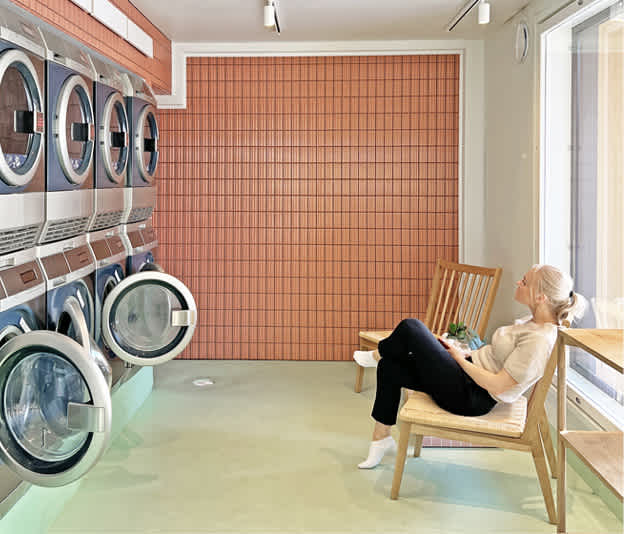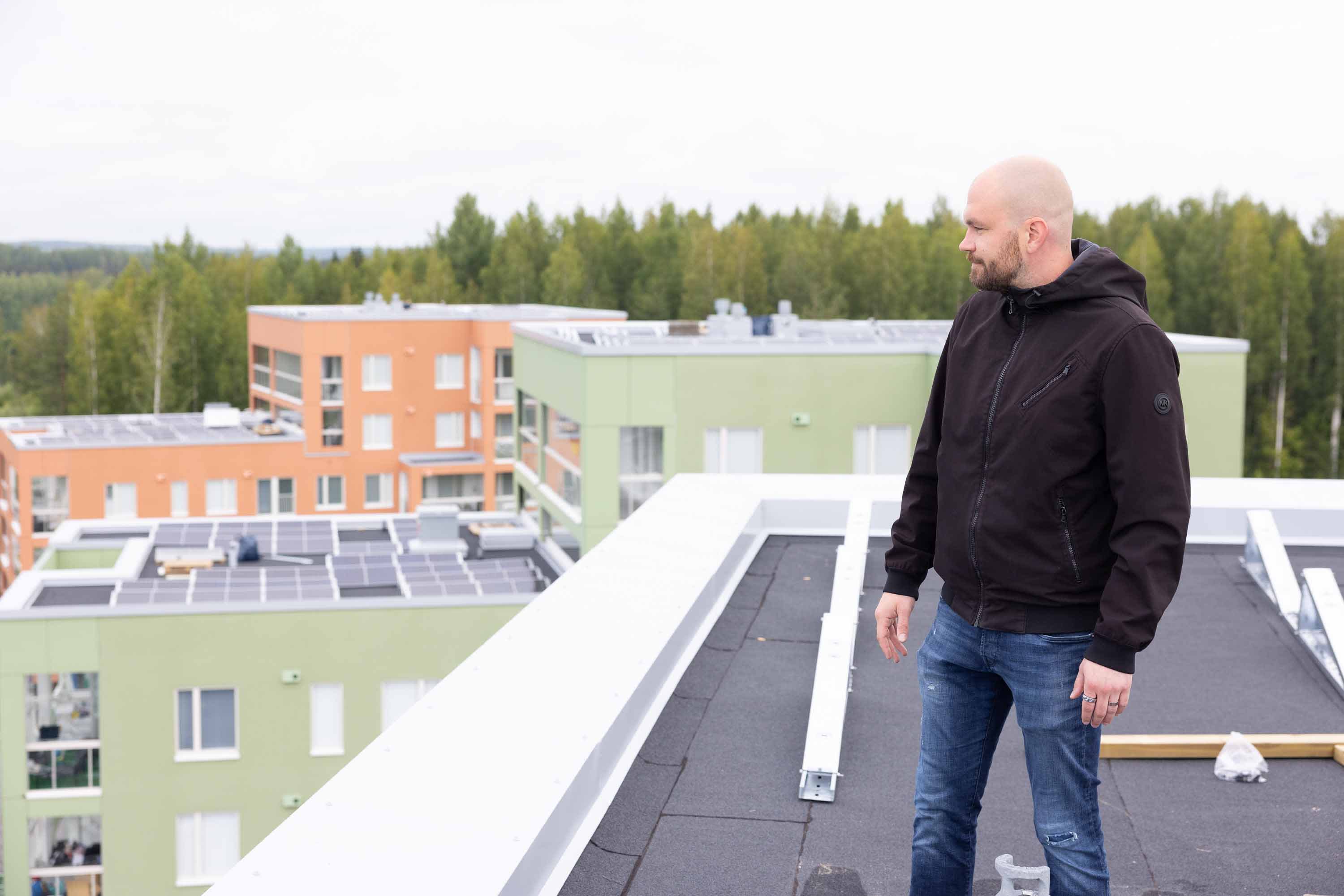Environmental wellbeing is at the heart of our sustainability efforts

This blog was originally published in Joo Group's annual review 2023. Read the annual review here.

In the energy-intensive property and construction sector, it’s crucial to pay special attention to environmental issues. We continuously assess the impact of our operations based on the EU’s taxonomy for sustainable finance, our carbon footprint, and our energy consumption.
Most of our operations are in line with the taxonomy for sustainable finance
The EU’s taxonomy for sustainable finance is a comprehensive set of criteria for an impartial and comparable assessment of the sustainability of different organisations. Two of these criteria specifically apply to existing properties, such as our apartment complexes:
- The requirement for energy efficiency
- Climate risk assessment and a corresponding action plan
The table below shows the excellent energy efficiency of our fully-owned properties, compared to the energy efficiency requirements of the taxonomy. Properties where we only own individual apartments are not included in this comparison.
In 2023, we conducted a climate risk assessment and developed a corresponding action plan for all the properties we own outright, ensuring our property portfolio complies with the taxonomy in terms of climate risks.
The significant risks identified in the assessment primarily related to rising heat loads and indoor temperatures. As a first response, we are gradually expanding the remote monitoring of room temperatures in our apartments across all our properties, as per the recommendations. Additionally, we are exploring, on a case-by-case basis for each apartment complex, improvements in ventilation, the installation of cooling systems, and passive cooling solutions as needed.
Risks associated with heavy rainfall or flooding also emerged for some of our apartment complexes. In these properties, we are arranging checks on the effectiveness and adequacy of stormwater systems, as well as other recommended measures.
Social minimum safeguards, including requirements related to respecting human rights, combating corruption, tax compliance, and ensuring fair competition, are also a fundamental part of the EU’s taxonomy for sustainable finance. We have verified that our operations already largely meet these requirements, and we will address any areas needing clarification during 2024. We are enhancing our ethical guidelines regarding anti-corruption measures and the assurance of fair competition, as well as expanding the training offered to our teams on these subjects.
The taxonomy focuses on the more permanent features of our property portfolio rather than our day-to-day operations. We examine the impacts of the latter by monitoring our carbon footprint and energy consumption, and the practical measures taken in these areas.
Aiming for carbon neutrality by 2035

Our operations in 2023 had a calculated carbon footprint of 26,490 tonnes of CO₂e (2022: 18,213 tonnes of CO₂e). This figure, derived from market calculations, includes all direct and indirect emissions as outlined by the international Greenhouse Gas (GHG) Protocol, such as the development of new properties, the energy consumption of both our operations and our residents, property maintenance, travel, and other procurements.
The increase in our carbon footprint from the previous year can be explained not only by the larger number of building projects completed during the year and the growth of our property portfolio but also by the inclusion of individual apartment ownerships in the calculations. The calculated energy consumption of these ownerships, compared to the previous year, was accounted for in 2023 for the first time, although actual consumption data for these properties was unavailable.
This change in the calculation method significantly increased market-based emissions estimates because we do have not directly arranged the electricity or heating contracts for these properties. Therefore, the calculated emissions rely on what is known as the residual mix emission factor, which is relatively high.
The electricity we procure ourselves has been predominantly renewable, and from 2024 onwards, all our contracts have been switched to renewable energy.
The distribution of emissions across different categories can be seen in the table below. To provide a sense of the scale of emissions, all direct and indirect emissions, excluding those from new developments, have been adjusted in relation to the average number of apartments over the year.
The calculated emissions per apartment in 2023 were 654 kg CO₂e (446 kg CO₂e in 2022). The inclusion of individual apartment ownerships in the calculations accounts for the increase in these emissions, too.
Each year, our calculations become more refined and accurate, which complicates year-on-year comparisons. For instance, in our initial carbon footprint calculation in 2021, emissions totalled only 5,095 tonnes, though the number of new developments was similar to that of 2023. However, the method for calculating emissions from new projects was different, resulting in substantially underestimated emission figures. Consequently, we have updated our calculations. We aim to further improve our methodology, while always striving to adhere closely to the GHG Protocol.
The ultimate purpose of a carbon footprint calculation is to gain a comprehensive understanding of the impacts of our operations, increase awareness internally and amongst our stakeholders, and steer our activities towards the most significant emission reduction measures. Our final goal for net emissions is zero. As a result, in 2023, we began developing a carbon neutrality roadmap in collaboration with the Finnish Green Building Council (FIGBC).
This roadmap outlines specific actions Joo Group will take to achieve carbon neutrality and their timelines. In line with the FIGBC’s #BuildingLife programme, our target year for achieving carbon neutrality is 2035.
At the time of writing, the first draft of the roadmap is complete, and we plan to publish the finished roadmap during 2024.
Our guiding principles in developing the roadmap have been to create real systemic impacts rather than just achieving carbon neutrality on paper. Naturally, we also want to help our residents in moving towards a more sustainable lifestyle. Examples of systemic impacts include ambitiously reducing energy use as well as procuring renewable energy, significant investments in solar power production exceeding our properties’ own electricity needs, participating in electricity and district heating demand response programs, and actively influencing these areas in partly owned apartment complexes.
The most challenging part of these efforts is making new construction developments low-carbon. To succeed in this, we require the broad support and participation of the entire construction sector. For spring 2024, we have scheduled a series of discussions and site visits with various construction partners to learn more about the subject and find practical ways to build more sustainably.
Update: Our roadmap was published on 13 September 2024. In the final version, the target year has been updated to 2045. Read more: Joo Group has published its carbon neutrality roadmap.
Our energy efforts produce tangible results

Our long-term energy work is bearing fruit, and the carbon neutrality roadmap will refine and enhance this effort further.
The accompanying table compares the consumption of electricity and district heating in our properties that have been completed and under our management since the beginning of 2022. In the comparable property portfolio, electricity consumption decreased by 1.6%, and district heating consumption by 4.9%.
By the end of 2023, we had switched all our fully-owned properties to renewable electricity. We also explored opportunities for procuring certified renewable district heating, and we will start procurement in 2024 wherever possible. In some of our apartment complexes, this procurement is already underway.
In 2023, we also took numerous other measures to reduce energy consumption. Besides continuing to install remote heating control systems in dozens of our properties, we started our first pilot project of participating in electricity demand response in one of our geothermal properties. What’s more, we installed pressure-reducing valves to decrease water consumption and expanded real-time, property-level monitoring of water consumption across nearly our entire property portfolio.
During the year, we installed solar energy systems in 31 of our properties. The combined capacity of these systems is 904 kW, with an expected annual yield of about 751 MWh. In 2024, we plan to install an equivalent amount of new solar power production capacity.
As in previous years, all our new developments in 2023 had the highest energy efficiency rating A. We will of course maintain this standard in 2024, too.
Read more


Joo Group's annual review for 2023 tells the story of our everyday at Joo
Read our annual review to find out what Joo team members think of the past year.


Better and more effective property management in-house
We have welcomed our first janitor and cleaning professionals to the Joo team in 2023.


Joo Group takes a big green leap – we're installing solar panels on dozens of rooftops
We want to be pioneers in energy efficiency by making green choices and supporting sustainable development.
